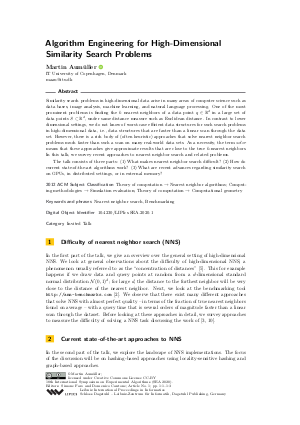Algorithm Engineering for High-Dimensional Similarity Search Problems (Invited Talk)
Author
Martin Aumüller 
-
Part of:
Volume:
18th International Symposium on Experimental Algorithms (SEA 2020)
Part of: Series: Leibniz International Proceedings in Informatics (LIPIcs)
Part of: Conference: International Symposium on Experimental Algorithms (SEA) - License:
 Creative Commons Attribution 3.0 Unported license
Creative Commons Attribution 3.0 Unported license
- Publication Date: 2020-06-12
File

PDF
LIPIcs.SEA.2020.1.pdf
- Filesize: 310 kB
- 3 pages
Document Identifiers
Subject Classification
ACM Subject Classification
- Theory of computation → Nearest neighbor algorithms
- Computing methodologies → Simulation evaluation
- Theory of computation → Computational geometry
Keywords
- Nearest neighbor search
- Benchmarking
Metrics
- Access Statistics
-
Total Accesses (updated on a weekly basis)
0Document
0Metadata
Abstract
Similarity search problems in high-dimensional data arise in many areas of computer science such as data bases, image analysis, machine learning, and natural language processing. One of the most prominent problems is finding the k nearest neighbors of a data point q ∈ ℝ^d in a large set of data points S ⊂ ℝ^d, under same distance measure such as Euclidean distance. In contrast to lower dimensional settings, we do not know of worst-case efficient data structures for such search problems in high-dimensional data, i.e., data structures that are faster than a linear scan through the data set. However, there is a rich body of (often heuristic) approaches that solve nearest neighbor search problems much faster than such a scan on many real-world data sets. As a necessity, the term solve means that these approaches give approximate results that are close to the true k-nearest neighbors. In this talk, we survey recent approaches to nearest neighbor search and related problems. The talk consists of three parts: (1) What makes nearest neighbor search difficult? (2) How do current state-of-the-art algorithms work? (3) What are recent advances regarding similarity search on GPUs, in distributed settings, or in external memory?
Cite As Get BibTex
Martin Aumüller. Algorithm Engineering for High-Dimensional Similarity Search Problems (Invited Talk). In 18th International Symposium on Experimental Algorithms (SEA 2020). Leibniz International Proceedings in Informatics (LIPIcs), Volume 160, pp. 1:1-1:3, Schloss Dagstuhl – Leibniz-Zentrum für Informatik (2020)
https://doi.org/10.4230/LIPIcs.SEA.2020.1
BibTex
@InProceedings{aumuller:LIPIcs.SEA.2020.1,
author = {Aum\"{u}ller, Martin},
title = {{Algorithm Engineering for High-Dimensional Similarity Search Problems}},
booktitle = {18th International Symposium on Experimental Algorithms (SEA 2020)},
pages = {1:1--1:3},
series = {Leibniz International Proceedings in Informatics (LIPIcs)},
ISBN = {978-3-95977-148-1},
ISSN = {1868-8969},
year = {2020},
volume = {160},
editor = {Faro, Simone and Cantone, Domenico},
publisher = {Schloss Dagstuhl -- Leibniz-Zentrum f{\"u}r Informatik},
address = {Dagstuhl, Germany},
URL = {https://drops.dagstuhl.de/entities/document/10.4230/LIPIcs.SEA.2020.1},
URN = {urn:nbn:de:0030-drops-120751},
doi = {10.4230/LIPIcs.SEA.2020.1},
annote = {Keywords: Nearest neighbor search, Benchmarking}
}
Author Details
References
-
Thomas D. Ahle, Martin Aumüller, and Rasmus Pagh. Parameter-free locality sensitive hashing for spherical range reporting. In SODA, pages 239-256. SIAM, 2017.

-
Martin Aumüller, Erik Bernhardsson, and Alexander John Faithfull. ANN-Benchmarks: A benchmarking tool for approximate nearest neighbor algorithms. Inf. Syst., 87, 2020. See https://arxiv.org/abs/1807.05614 for an open access version.

-
Martin Aumüller and Matteo Ceccarello. The role of local intrinsic dimensionality in benchmarking nearest neighbor search. In SISAP, volume 11807 of Lecture Notes in Computer Science, pages 113-127. Springer, 2019.

- Martin Aumüller, Tobias Christiani, Rasmus Pagh, and Michael Vesterli. PUFFINN: parameterless and universally fast finding of nearest neighbors. In ESA, volume 144 of LIPIcs, pages 10:1-10:16. Schloss Dagstuhl - Leibniz-Zentrum für Informatik, 2019. URL: https://github.com/puffinn/puffinn.
-
Kevin S. Beyer, Jonathan Goldstein, Raghu Ramakrishnan, and Uri Shaft. When is "nearest neighbor" meaningful? In ICDT, volume 1540 of Lecture Notes in Computer Science, pages 217-235. Springer, 1999.

-
Tobias Christiani. Fast locality-sensitive hashing frameworks for approximate near neighbor search. In SISAP, volume 11807 of Lecture Notes in Computer Science, pages 3-17. Springer, 2019.

-
Yihe Dong, Piotr Indyk, Ilya Razenshteyn, and Tal Wagner. Learning space partitions for nearest neighbor search. In International Conference on Learning Representations, 2020.

-
Fabian Fier, Nikolaus Augsten, Panagiotis Bouros, Ulf Leser, and Johann-Christoph Freytag. Set similarity joins on MapReduce: An experimental survey. PVLDB, 11(10):1110-1122, 2018.

-
Fabian Groh, Lukas Ruppert, Patrick Wieschollek, and Hendrik Lensch. Ggnn: Graph-based gpu nearest neighbor search. arXiv preprint arXiv:1912.01059, 2019.

-
Junfeng He, Sanjiv Kumar, and Shih-Fu Chang. On the difficulty of nearest neighbor search. In ICML. icml.cc / Omnipress, 2012.

- Xiao Hu, Ke Yi, and Yufei Tao. Output-optimal massively parallel algorithms for similarity joins. ACM Transactions on Database Systems, 44(2):1-36, April 2019. URL: https://doi.org/10.1145/3311967.
- Piotr Indyk and Rajeev Motwani. Approximate Nearest Neighbors: Towards Removing the Curse of Dimensionality. In Proceedings of the Thirtieth Annual ACM Symposium on Theory of Computing, STOC '98, pages 604-613, New York, NY, USA, 1998. ACM. URL: https://doi.org/10.1145/276698.276876.
- M. Iwasaki and D. Miyazaki. Optimization of Indexing Based on k-Nearest Neighbor Graph for Proximity Search in High-dimensional Data. ArXiv e-prints, October 2018. URL: http://arxiv.org/abs/1810.07355.
-
Tim Kraska, Alex Beutel, Ed H Chi, Jeffrey Dean, and Neoklis Polyzotis. The case for learned index structures. In Proceedings of the 2018 International Conference on Management of Data, pages 489-504, 2018.

-
Thijs Laarhoven. Graph-based time-space trade-offs for approximate near neighbors. In Symposium on Computational Geometry, volume 99 of LIPIcs, pages 57:1-57:14. Schloss Dagstuhl - Leibniz-Zentrum für Informatik, 2018.

-
Yury A. Malkov and D. A. Yashunin. Efficient and robust approximate nearest neighbor search using hierarchical navigable small world graphs. IEEE Trans. Pattern Anal. Mach. Intell., 42(4):824-836, 2020.

- Willi Mann, Nikolaus Augsten, and Panagiotis Bouros. An empirical evaluation of set similarity join techniques. Proceedings of the VLDB Endowment, 9(9):636-647, May 2016. URL: https://doi.org/10.14778/2947618.2947620.
-
Samuel McCauley and Francesco Silvestri. Adaptive MapReduce similarity joins. In BeyondMR@SIGMOD, pages 4:1-4:4. ACM, 2018.

-
Milos Radovanovic. Hubs in nearest-neighbor graphs: Origins, applications and challenges. In WIMS, pages 5:1-5:4. ACM, 2018.

- Suhas Jayaram Subramanya, Devvrit, Rohan Kadekodi, Ravishankar Krishnaswamy, and Harsha Simhadri. DiskANN: Fast accurate billion-point nearest neighbor search on a single node. In NeurIPS 2019, November 2019. URL: https://www.microsoft.com/en-us/research/publication/diskann-fast-accurate-billion-point-nearest-neighbor-search-on-a-single-node/.
